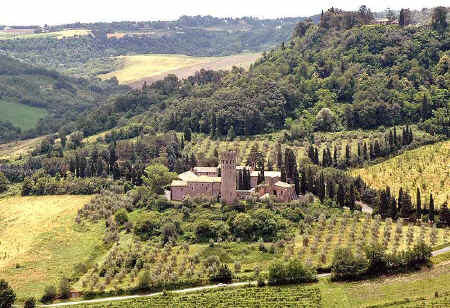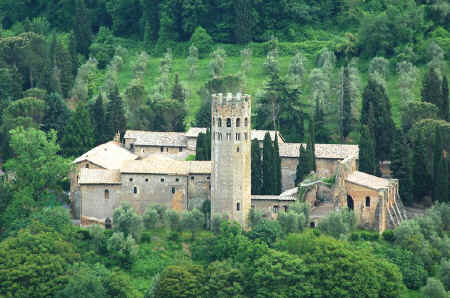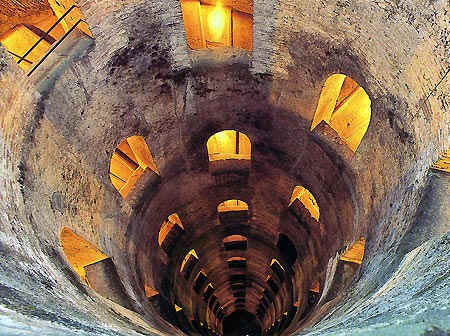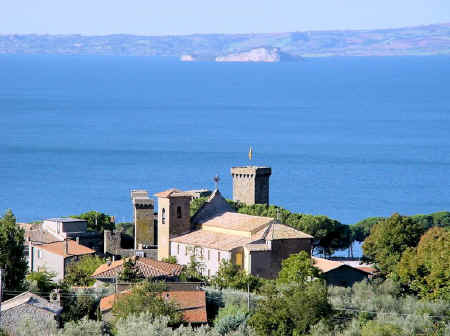|
The origin of the name Orvieto is unresolved. The city stands on a
huge mass of tufa rock delimited by vertical cliffs, a geomorphology
that would have made it irresistible as a site for fortification to the
earliest inhabitants of the territory. It is near the rivers Paglia and
Chiana, the swamps of which were drained by
Pope Sixtus V. Orvieto could be the ancient Hebanum or Oropitum,
or it could have been the ancient port (therefore Urbs vetus, or old city) of the Etruscan city of
Volsinii, which was destroyed by the Romans at some stage and rebuilt on the site of the present
Bolsena. In the countryside around Orvieto there are many Etruscan
tombs and Orvieto itself is the site of numerous Etruscan works. The name of Urbs Vetus appears for the first time in
Procopius, corrupted into Urbebentum. It is also found in the writings of St. Gregory the Great. The Abbey of Saints Severus and Martyrius
Early History of OrvietoOrvieto was annexed by Rome in the 3rd century BC. After the collapse of the Roman Empire its defensible site gained new importance: the episcopal see was transferred from Bolsena, and the city was held by Goths and by Lombards before its self-governing commune was established in the 10th century, in which consuls governed under a feudal oath of fealty to the bishop. Orvieto's relationship to the papacy has been a close one; in the tenth century Pope Benedict VII visited the city of Orvieto with his nephew, Filippo Alberici, who later settled there and became Consul of the city state in 1016. Orvieto in the middles ages In the mediaeval period, the beautiful public buildings such
as the Palazzo Comunale, the Palazzo del Popolo, the Cathedral and the Palazzo dei Sette rose
beside the older churches such as San Giovenale, Sant'Andrea, and the convents of San
Domenico, San Francesco, Sant'Agostino and Santa Maria dei Servi, the complex of the Papal Palace, and the private palaces and tower houses of the aristocracy. Orvieto and the ChurchThe first known Bishop of Orvieto was John (about 590), and in 591 appears a Bishop Candidus; among its other prelates were Constantino Medici, O.P., sent by Alexander IV in 1255 to Greece, where he died; Francesco Monaldeschi (1280), who did much for the construction of the cathedral. In 1528 Clement VII sought refuge at Orvieto, and while there ordered the construction of the "Pozzo di San Patrizio" (the well of St. Patrick), by Sangallo. Bishop Sebastiano Vanzi (1562) distinguished himself at the Council of Trent and built the seminary, which was enlarged afterwards by Cardinal Fausto Polo (1645) and by Giacomo
Silvestri, the latter of whom gave to it the college and other property of the Jesuits (1773); Cardinal Paolo Antamori (1780) caused the history of the cathedral of Orvieto to be written by Guglielmo della Valle; and lastly
G.B. Lambruschini (1807). The Miracle of Bolsena The Miracle of Bolsena is not supported by strong historical evidence, and its tradition is not altogether
consistent, for in the first place Urban IV makes no mention of it in the Bull by which he established the feast of Corpus Christi, although the miracle is said to have taken place in his day and to have determined him in his purpose of establishing the
feast. Likewise, the two biographers of Pope Urban impugn the truth of this tradition by their silence, i.e.,
Muratori, "Rerum Italicarum scriptores", III, pt. l, 400 sq.; and especially Thierricus
Vallicoloris, who, in his life of the pope in Latin verse, describes in detail all the acts of the pontiff during the latter's stay at
Orvieto, referring elsewhere also to the devotion of Urban in celebrating the Mass, and to the institution of the Feast of Corpus Christi, without at any time making allusion to the miracle at
Bolsena. The latter is related in the inscription on a slab of red marble in the church of St. Christina, and is of later date than the
canonisation of St. Thomas Aquinas (1328). The oldest historical record of the miracle is contained in the enamel "histories" that adorn the front of the reliquary (1337-39). It is to be noted that in the narratives of the miracle cited by Fumi (Il
Santuario, 73) the reliquary only is called "tabernaculum D.N.J.C.", or "tab . . . pro
D.N.J.C." or, again, "tabernacolo del Corpo di Xpo." |




